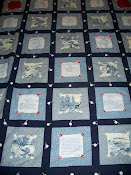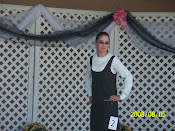We All Learn At a Different Pace
What did I learn about myself through my 4-H participation?
I learned that it is not easy to be 16 and on the edge of adulthood.
Head - to clear thinking, when giving your word to someone, think about how it will affect your heart if you buckle to peer pressure and go against your morals and ethics .
Heart - to greater loyalty; loyalty is something that is given freely and cannot be demanded or forced upon someone.
Hands - to larger service, you can only do what you feel is right and work hard to achieve your goals.
Health - to better living; if your word is your honor, and you stand fast to your morals and ethics; loyalty will come to you freely, your goals will be realized, and you will make a difference in the world around you.
I love 4-H !
Peer pressure is one of the hardest things we face; stay true to yourself no matter how hard it is and make a difference!
Farmer's Hands Video
Tuesday, March 30, 2010
Beef Quality Assurance
Beef Quality Assurance is a national program that provides guidelines for beef cattle production. The program raises consumer confidence through offering proper management techniques and a commitment to quality within every segment of the beef industry.
“BQA is a process of figuring out what could go wrong, planning to avoid it – then validating and documenting what you have done. BQA is just part of good business,” explains Dee Griffin, DVM, associate professor at the University of Nebraska
Youth BQA objective
Youth BQA assist youth in understanding their role as producers in the food supply chain and their responsibility to produce a safe food product while caring for animals is an ethical manner.
Monday, March 29, 2010
Swine Judging Work Shop and Judging Contest

The Swine Judging Workshop and Contest was held on March 27 at the Minidoka County Fairgrounds. Sign-in was at 9a.m.
 Before I could even leave home I had to feed and water my steers and horses; so I had to get up really early, for it was a 1 1/2 hour drive to Minidoka. There was a team from Idaho Falls that had to get up even earlier than I did.
Before I could even leave home I had to feed and water my steers and horses; so I had to get up really early, for it was a 1 1/2 hour drive to Minidoka. There was a team from Idaho Falls that had to get up even earlier than I did.The workshop started at 10a.m. for me it was all new; I have never been to a swine work shop and had NO knowledge of swine, not a clue to what they even eat.
The workshop and judging contest lasted all day. There was so much to learn. I now look at Pigs - Swine different; Their not just ham or bacon any more.
Did you know? That pigs can not sweat (perspire) to cool off. (I didn't) Because a pigs skin is so thick and they are insulated by a layer of fat, the pig must cool itself by lying in water or mud. Just a little FYI !
Back to the Workshop;
We learned how to fill out the judging card, how to take notes, and what to look for when judging swine. All of this before lunch.
After lunch we learned Terms and Transition, Muscle and Preformance, Volume and Trimness, Structure and Balance and how to format oral reasons.
--We also had guess speaker Scott Nash.

And guest speaker Tim Hooper
from the Idaho Jr. Show Pig Association
Here are a few pictures of the events of the day

Well My brain is so full of information; guess I will take a break from thinking and let it soak in for a bit.
Stay cool and keep it natural.
And don't forget to sign my guest book.
Thursday, March 25, 2010
Livestock Judging, What is it?
Livestock Judging, What is it?
Judging activities provide youth with an opportunity to develop communication, decision making and organizational skills, and enhance their confidence and self esteem.
Judging is usually a team effort, but individuals can also participate. Three to four youth on a team will judge various classes of livestock. Typically market and breeding beef, sheep, and swine species are used in a contest. Youth will judge each class (consisting of 4 animals) and an official judge will give his placing. Youth are then scored compared to the official judge. Oral reasons may or may not be included in a contest. If a contest does have a reasons class, youth will judge the class and take notes as to why they placed the class the way they did. Youth will then get an opportunity to work and rewrite their notes into reasons. Once they are finished, then youth will present their reasons to one person and they will receive a score to be added to their overall score. New this year is the Southern III District Livestock Judging Program. There are multiple scheduled days around the district this spring and summer. The goal of the Livestock Judging Program is to help youth and adults learn; 1. What to look for when judging animals 2. How to take notes 3. Understanding terms and animal parts 4. How to format and give oral reasons.
Cindy A. Kinder Extension Educator Gooding County Idaho
Saturday, March 20, 2010
My 2010 4-H Steers
This is Pepper he weighed in at 878 pounds.
Black Angus
And this is George he weighed in at 868 pounds. Red Angus
All my steers lead and behaved very well the weigh-in process went very smooth; but they were glad to get home.
Now it is time to set the feeding, exercise, and training schedules.
Let the fun begin!!
Friday, March 19, 2010
Selecting 4-H Market Livestock Project Animals
The first concept that needs to be understood is that selecting animals for a Systems Approach program is not the same as selecting a "show" animal to be groomed, molded and manipulated to fit the current fad of the show ring. With the "Systems Approach", animals are selected which, with proper management, will meet the typical standards for efficiency, profitability, and usefulness to the production, feedlot and packing industry and at the same time exhibit a high degree of acceptance by the consumer.
The Systems Approach project evaluation is based on achievement of standards for selection, management and efficient production of meat that is desirable to packer and consumer. The project evaluation card uses four categories to evaluate member achievement and success. The Lean Yield section of the card indicates the degree of success in selecting and producing a lean product profitable to the packer and desired by consumers. The Conformation/Usefulness evaluation looks individually at muscling, trimness, growth and frame and structure and balance. These factors are representative of potential for achieving a desirable yield grade, a high degree of production efficiency, a high level of consumer satisfaction and a desirable degree of longevity. The gain and quality grade section evaluates both profitability and consumer desirability. The rate of gain section recognizes successful animal management in achieving a high level of efficiency and profitability. Gain is rated higher for higher quality animals where each pound of gain is more valuable.
The primary purpose for selecting animals is to obtain an animal that when properly fed and managed will represent the best in the industry. This means that industry standards must be identified prior to selection. The following standards represent industry goals achievable by most youth livestock program participants. Judges use the "Systems Approach" evaluation card to provide an evaluation of these standards. Animal selection is guided by the same standards that are used to evaluate accomplishment.
TABLE 1. Typical minimum standards for performance and quality.
BEEF
USDA yield grade 3.0 or less.
Live weight 1150 to 1300 lb.
Minimum 2.8 lb. ADG.
Conformation Score of 22 or >.
PIGS
USDA grade of No. 1.
Muscle score of 7 or higher.
Live weight 240 to 270 lb.
Minimum 1.85 lb. ADG.
Conformation Score of 22 or >.
LAMBS
USDA Choice Y.G. 2 or >.
Muscle score of 7 or higher.
Live weight 115 to 145 lb.
Minimum 0.75 lb. ADG.
Conformation Score of 22 or >.
just click the link below to read it all.
this is a place to learn about selecting 4-H market livestock animals
written by: Chad C. Gibson, Gene W. Gibson, Jeff Goodwin
Wednesday, March 17, 2010
Weigh In is almost here
After weigh in I will take my before pictures and post them so that you can see my steers.
Check back this weekend and check it out.
Just a reminder to please sign my guest book.








































